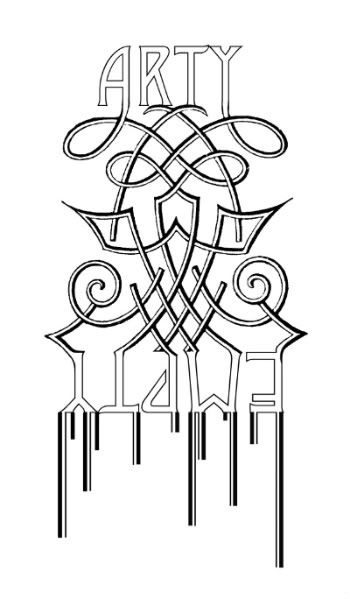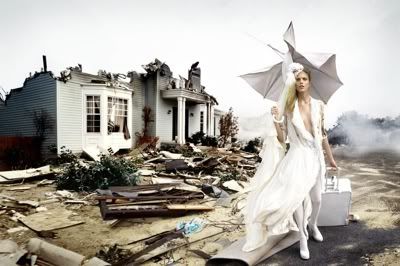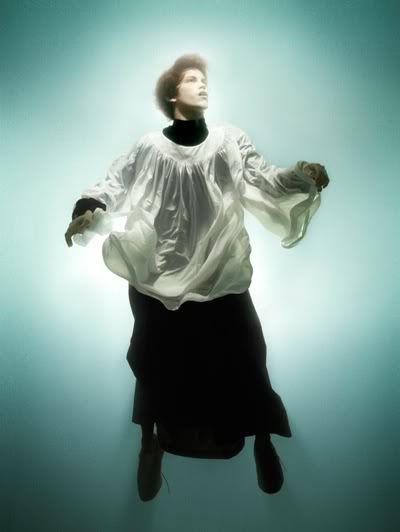Genesis P-Orridge, chanteur leader des Throbbing Gristle, semble tout droit sorti d’une photo de David Lachapelle. Il en a l’extravagance décalée et porte sur son visage les traces de sa dimension artistique. Il n’est d’ailleurs pas sans rappeler Amanda Lepore, la « muse » du photographe américain. Transatlantique, transgenre, transexualisé. L’ombre derrière la couleur.
Le vénérable Hôtel de la Monnaie consacre une rétrospective particulièrement intéressante à David Lachapelle, l’enfant terrible de la photo internationale, jusqu’au 31 mai 2009. L’exposition commence de manière surprenante à rebours, partant des derniers travaux de Lachapelle pour remonter à ses débuts fulgurants, retour vers les icones originelles. On peut rapidement faire un découpage en 3 temps, sorte de trilogie démoniaque, correspondant avec précision aux 3 temps de la carrière de Genesis P-Orridge. Prenons le revers du rebours et remontons, sans nostalgie, aux origines. David Lachapelle, comme Genesis P-Orridge, avaient, dès le départ, tout compris. L’un dans la mode, l’autre dans le rock. Les deux incarnaient à merveille, dans leur domaine respectif, l’application d’une intelligence implacable. David Lachapelle réalisait des portraits de célébrités ou d’anonymes (Angelina Jolie in Poppy Field, Milk Maid) avec une grâce innovatrice et sans équivalent. Un style reconnaissable immédiatement, une technique inimitable, une révolution en cours et l’application magistrale que c’est en donnant à voir que l’on impose un concept esthétique. C’était exactement la même chose chez Throbbing Gristle : la compréhension que c’est dans le cadre délimité du rock que la révolution est la plus incroyable, telle une implosion contenue et continue, le groupe anglais menait une guerre sainte affolante. Réussir à modifier les règles du jeu, à être libre dans le droit (un certain droit disons), c’est terrasser le dragon.
En remontant le Styx, on arrive à la Révélation, l’exploration mystique qui prend la forme chez Lachapelle des séries Heaven to Hell ou le Déluge. Cette possession religieuse trouve son équivalent chez les Psychic TV de Genesis P-Orridge. Tentant la conversion plus ou moins spontanée d’adeptes industriels, il instaure lui aussi une dimension quasi œcuménique de regroupement nébuleux autour du TOPY (Temple Ov Psychick Youth). C’est l’heure du prêche et des interrogations transcendantales. Tous deux semblent vouloir se retrouver dans une sorte de foi déviée et déviante, abjurant leurs pêchés dans un blasphème artistique. Ils cherchent à nous montrer la voie, à nous accompagner vers leur au-delà, à nous faire pénétrer la vision, à nous ouvrir le troisième œil. Ils ouvrent surtout la mer de la rupture.
Troisième et dernier mouvement de l’évolution, la sortie du format. David Lachapelle explore la 3ème dimension avec des installations de carton tirées de ses photographies alors que Genesis P-Orridge exhorte, exulte, existe à travers Thee Majesty, manifestant ainsi l’âme de Lady Jaye. Les tirages boursouflés de Lachapelle (Holy War) tirent leur intérêt uniquement du matériau pauvre qu’est le carton et qui s’allie à merveille à son exploration du futile et du fragile. Pour le reste, les thématiques (Guerre Sainte, combat du consumérisme exacerbée, rédemption dans la luxure), l’aspect terriblement didactique, les compositions surfaites, font des dernières œuvres de Lachapelle de terribles monstruosités d’inutile. Telle une grenouille voulant devenir bœuf, en désirant changer de statut, de dimension, du photographe à l’artiste, il passe de l’artiste au photographe. A trop vouloir en dire, mal, on finit par gâcher le message et sombrer dans un n’importe quoi ravageur. Thee Majesty active des ressorts similaires. A trop vouloir en dire, mal, on finit par gâcher le message. Le n’importe quoi est moins ravageur puisqu’il se cantonne au champ musical, même s’il veut s’enorgueillir, s’anoblir sous les ors métalliques du Centre Pompidou ou se rapprocher de démarches Orlanesques. Pourquoi rechercher le soleil quand on brille autant dans l’ombre ? Ils maîtrisaient tous deux à merveille leur art. Ils nous laissaient le choix, le droit de réinterpréter, de comprendre, ou non, une démarche novatrice et solitaire. Ils marchent désormais parmi les autres, parmi une foule d’anonymes célèbres.
Quel salut désormais ? Il est toujours passionnant de voir l’évolution d’un artiste sur le long terme, empêchant les jugements hâtifs, et apercevant la lutte perpétuelle sur de longues périodes. Une nouvelle drôle de guerre en quelque sorte. N’oublions pas qu’ils sont toujours capable de moments de Grâce véritable. Le talent après tout, c’est comme le vélo, ça ne s’oublie pas : les séries Awakened et Recollections in America (où Lachapelle devient artiste), les albums Part two. The endless Not et PTV3 (où Genesis se remémore qu’il est encore capable d’inventer le futur). Peut-être leur reste-t-il, dès lors, à essayer une alliance naturellement contre-nature. Oseront-ils tenter le diable et créer Lachapelle Ov Psychick Youth ? On peut tout attendre de ces deux Sacrés Monstres…
David Lachapelle: maximal exuberance.
Genesis P-Orridge, lead singer of the Throbbing Gristle, seems to escape from a photograph by David Lachapelle. He is extravagantly bizarre and wears on his face traces of his artistic dimension. He reminds us Amanda Lepore, American photographer’s “muse”. Transatlantic, transgender, transsexual. The shadow behind the color.
The venerable Hotel de la Monnaie, Paris, devotes a particularly interesting retrospective to David Lachapelle, the enfant terrible of the international photography, to May 31, 2009. Surprisingly, the exhibition begins backwards, starting with the latest works and going back to his brilliant beginning, coming back to original icons. We can quickly cut his work on 3 periods, a kind of evil trilogy, corresponding precisely to 3 different periods of Genesis P-Orridge’s carrier. Let’s take backwards from the rear and go back to genesis, without nostalgia. David Lachapelle, like Genesis P-Orridge, from the very beginning, understood everything. The first one on fashion, the other one on rock music. Both incarnate, on their respective domain, the application of an implacable intelligence. David Lachapelle made portraits of famous or anonymous people (Angelina Jolie in Poppy Field, Milk Maid) with an innovative and like anything grace. A style immediately recognizable, an inimitable technique, a running revolution and the brilliant application that you implement an aesthetical concept by giving to see. It’s exactly the same thing with the Throbbing Gristle: they understood that the revolution was the most astonishing on the limited framework of rock music, as a continued and contained implosion, the English band led a frightening holy war. To modify game rules, to be free under laws (well, special laws), it’s like striking down the dragon.
Sailing up the Styx, you arrive to Revelation, the mystical exploration: the Heaven to Hell or Deluge series by Lachapelle. This religious possession is equivalent to Psychic TV, Genesis P-Orridge band. He attempts the more or less spontaneous conversion of industrial adepts, implementing a quasi-ecumenical dimension of nebulous grouping around the TOPY (Temple Ov Psychick Youth). It’s time for preaching and transcendental questioning. Both wish to find themselves on a deviate and deviant faith, forswearing their sins on an artistic blasphemy. They try to show us the way, to lead us to their own after-life, to make us penetrate the vision, to open our third eye. They mostly open the sea of rupture.
Third and last movement of the evolution, the format exit. David Lachapelle explores the 3rd dimension with cardboard installations issued from his photographs and Genesis P-Orridge exhorts, exults, exists through Thee Majesty, expressing Lady Jaye’s soul. The puffy impressions of Lachapelle (Holy War) are only interesting by the poor material (cardboard) perfectly combining with his exploration of futility and fragileness. The rest, the themes (Holy War, worsened consumerism fight, redemption on lust), the terribly didactic aspect, the overrated compositions, transform Lachapelle’s latest works into monsters of inutility. Like the frog wishing to be as big as the ox, wanting to change his status, his dimension, from photographer to artist, he changes from artist to photographer. By keeping on wanting to say too much, badly, you end by spoiling the message and sinking into a devastating anything. Thee Majesty is on the same display. By keeping on wanting to say too much, badly, you end up by spoiling the message. The anything is less devastating because it stays on a musical field, even if it wants to pride itself, to ennoble itself under the metallic gildings of the Pompidou Center or comes closer to Orlanesc reasoning. Why looking after the sun when you shine so much on the shadow? They both totally mastered their art. They left us the choice, the right to reinterpret, to understand, or not, an innovative and solitarian reasoning. They walk now among others, in the middle of a crowd of famous anonymous.



Aucun commentaire:
Enregistrer un commentaire